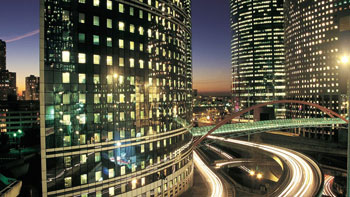Page 1 Page 2

Warning: Plot spoilers below for Driver and Cosmopolis
Although the character of Driver (Ryan Gosling) in Drive is not a criminal as such, his association as a getaway driver for robberies is a night-time endeavor. Here, the city is presented as a derelict sprawl; the landscape is expansive with concrete, windowless warehouses and factories lining up along the dimly-lit and deserted streets. Driver is a recluse in the same sense that Travis Bickle from Taxi Driver is a recluse. Like Bickle, Driver’s interactions with people are awkward and guarded; he lives so much within his own mind that other people do not really register. Perhaps the city he inhabits is a bustling metropolis, but his world is so internal that the commotion of everyday life is not on his radar. When he does drop his guard and begins a friendship with his neighbor, Irene (Carey Mulligan), and her young son, Benicio, he permits himself a weakness that will be eventually exploited. When the young woman’s husband returns from prison and is badly beaten by his former associates, Driver agrees to help with a robbery that will seal a debt and keep Irene and Benicio safe from harm. The robbery takes place during the daytime and goes horribly wrong (an example reiterating the concept that criminals should only operate at night). Driver gets caught up in a criminal underworld that he doesn’t understand and wants no part of. He intends to return the stolen money to the mob bosses, an honest move that the bosses can’t comprehend. Unfortunately, the only exit from the depths Driver has descended into is death. He is stabbed by the mob boss and takes the last moments of his life to drive the streets of LA whilst bleeding from his wounds.
In David Cronenburg’s Cosmopolis, the city is seen from the moving window of young billionaire Eric Packer’s sound-proof stretch limousine. Cosmopolis represents the rottenness of capitalism within the city. Packer is a cold and calculating financial speculator travelling across Manhattan to get a haircut from his favorite barber. Although a very real threat has been placed on his life, he seems unconcerned and continues his journey with regular updates on his safety coming from his personal bodyguard. Packer’s isolation from the world is so apparent that he takes business meetings in his car along the way. When anti-capitalist protestors spray paint and bombarded his limo with dead rats, he and his Chief Advisor (Samantha Morton) do not so much as bat an eyelid at this vandalism.
The city Packer inhabits is soundless and isolated. In the evening when he sits in a fancy restaurant with his new wife, who is as cold and isolated from the rest of the world as he is, he comments that the protestors have vacated the city, an example that the ordinary people have left, or have been hustled away from the city that is now left to the lizards and criminals. He also confesses to his wife that his business deals have turned sour and his company is now hemorrhaging money. Packer himself descends into violence and criminality as his capitalist world collapses around him. He abruptly kills his bodyguard and confronts Benno Levin, the man who is trying to kill him (Paul Giamatti). Levin, a former employee of Packer’s company, places the blame of the world’s capitalist insatiability on Packer’s head. Levin stands behind a passive and emotionless Packer with a loaded gun to Packer’s head. The film ends, but we assume Levin pulls the trigger.
Although capitalism plays a major part of the narrative in Cosmopolis, demonstrating the nadir of wealth and greed gone sour, its effects are also apparent in the films Collateral and Drive. The city that Vincent and Max cruise through is awash with unfettered wealth, and on the flip-side, hardship and crime. The economic divide is exemplified by Vincent and Max’s brief relationship. To the sophisticated Vincent, Max is a lowly taxi driver whom he can bribe with the promise of a nights’ earnings; whilst Max initially views Vincent’s charm and sophistication as something to which he aspires. In Drive, the city is derelict with abandoned windowless factories and cramped and dingy living quarters. This area of the city reflecting the consequence of factory jobs being shipped elsewhere, making the streets a lonely and desolate place. The city at night is a treacherous place for the three protagonists of Collateral, Cosmopolis and Drive. They mingle or align themselves with the criminal underworld and descend into an even murkier underbelly of violence and murder that eventually leads to their own demise. Much like the mythical vampire, who roams the night in search of blood and vice, but must return to the crypt as daytime arrives, these characters cannot be allowed to survive in the daytime. As time runs out for Vincent, Eric and Driver they face their own mortality. The city is literally the death of them.
Page 1 Page 2
Pages: 1 2

